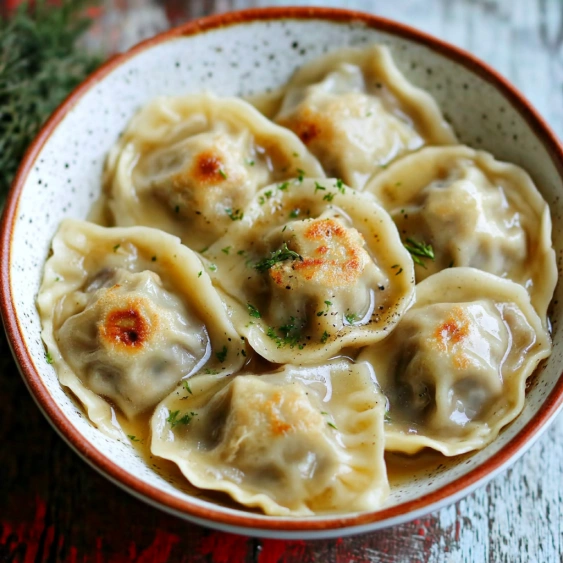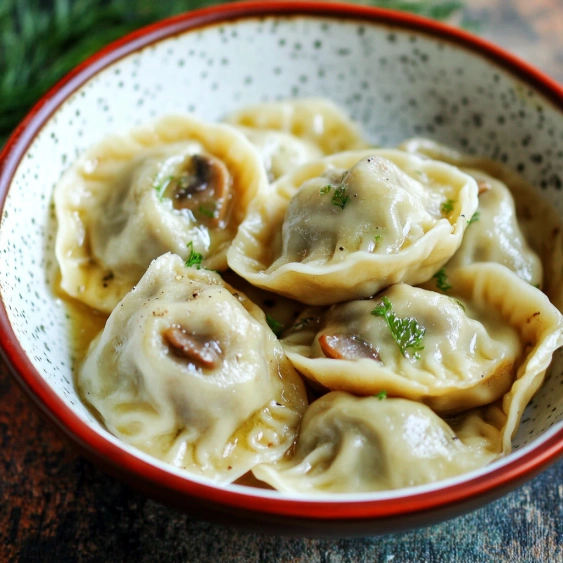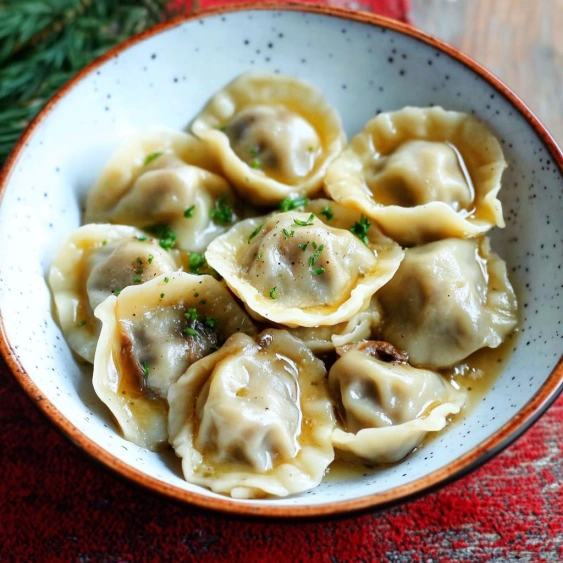 Pin it
Pin it
This classic Polish porcini mushroom dumpling recipe transforms simple ingredients into delicate, flavorful uszka perfect for special occasions. The earthy mushroom filling wrapped in a soft dough creates dumplings traditionally served with Christmas borscht, though they're delicious year-round.
The first time I made these dumplings was for a holiday gathering with Polish friends. They immediately transported back to their childhood Christmas Eve dinners, and now these little mushroom parcels have become our own family tradition during winter celebrations.
Ingredients
- All purpose flour: Creates the perfect tender texture while providing structure
- Very warm water: Activates the gluten for a pliable dough that seals well
- Butter: Adds richness look for unsalted European style for authentic flavor
- Fine sea salt: Enhances all the flavors without overpowering
- Dried porcini mushrooms: Provide intense earthy flavor look for ones with strong aroma
- Finely chopped onion: Adds sweetness and depth choose yellow onions for best results
- Vegetable oil: For sautéing, a neutral oil works best
- Soy sauce: Adds umami depth and saltiness use light soy sauce for best results
- Breadcrumbs: Help bind the filling and absorb excess moisture fresh or dried work well
- Salt and pepper: To taste always taste before filling the dumplings
Step-by-Step Instructions
- Prepare Mushrooms:
- Start by cleaning the dried porcini thoroughly under cold water to remove any grit or debris. Rub them gently between your fingers to dislodge dirt particles. After rinsing, place in a pot with enough fresh water to fully submerge them. Allow them to soak for exactly 10 minutes to rehydrate. Then bring to a boil with the lid on before reducing to a simmer for a full 30 minutes until tender. This slow cooking extracts maximum flavor.
- Make Dough:
- Place flour in a large bowl and create a well in the center. Add salt and butter or oil to the well. Gradually pour in very warm water while stirring with a fork to incorporate. The mixture will initially look shaggy and uneven. Continue mixing until all flour is moistened. The warmth of the water helps activate the gluten development.
- Knead Dough:
- Transfer your dough onto a lightly floured surface. Using the heels of your hands, push the dough forward and fold it back onto itself. Rotate a quarter turn and repeat for about 6 minutes until the dough becomes smooth and elastic. If it sticks excessively, add minimal flour, no more than a teaspoon at a time. Cover with an inverted bowl or plastic wrap and let rest for 15 minutes to relax the gluten.
- Prepare Onions:
- Heat vegetable oil in a skillet over low heat. Add finely chopped onions and cook for 3-4 minutes, stirring frequently. The onions should become translucent and soft but not brown. Browning creates bitter compounds that will affect your filling. Remove from heat immediately when softened.
- Create Filling:
- Strain the cooked mushrooms thoroughly, pressing gently to remove excess liquid. Save this flavorful mushroom broth for other recipes. Roughly chop the strained mushrooms to maintain some texture. Combine with sautéed onions, soy sauce, and seasoning in a food processor. Pulse until the mixture becomes cohesive and sticky while maintaining some textural elements. Stir in breadcrumbs by hand to absorb moisture and help bind the filling. Taste and adjust seasoning as needed.
- Roll Out Dough:
- Divide your rested dough into 2-3 manageable portions. Keep unused portions covered to prevent drying. On a lightly floured surface, roll one portion to approximately 2mm thickness. The dough should be thin but not transparent. Using a 2.3 inch (6cm) round cutter or glass rim, cut circles from the dough. Gather scraps and combine with remaining dough.
- Form Uszka:
- Place a small teaspoon of filling in the center of each dough round. Be careful not to overfill or the dumplings may burst during cooking. With dry fingertips, press edges together firmly to seal, forming a semicircle. Then bring the two corners toward each other and press to connect, creating the characteristic ear shape of uszka. Place completed dumplings on a floured surface and cover with a clean tea towel to prevent drying.
- Cook Dumplings:
- Bring a large pot of generously salted water to a rolling boil. Carefully add dumplings one by one, stirring gently with a wooden spoon to prevent sticking. Work in batches to avoid overcrowding. When dumplings float to the surface, continue cooking for 3-4 minutes until the dough is fully cooked through. Remove with a slotted spoon to a lightly oiled plate to prevent sticking.
- Serve Dumplings:
- Serve hot alongside traditional Christmas borscht, traditionally placing 4-5 dumplings per portion. The earthy mushroom flavor perfectly complements the tangy beet soup for a classic Polish holiday combination.
 Pin it
Pin it
The humble porcini mushroom truly transforms these dumplings. I remember my Polish grandmother teaching me how to identify the perfect balance of filling to dough, saying good uszka should be just one perfect bite of earthy mushroom flavor wrapped in tender dough. This recipe captures exactly that essence.
Storage Tips
Freshly made uszka will keep in the refrigerator for up to 3 days. Store them in an airtight container with a light coating of oil to prevent sticking. For longer storage, freeze uncooked dumplings on a floured tray until solid, then transfer to freezer bags. Cook frozen dumplings directly from frozen, adding 1-2 minutes to the cooking time. The filling can also be prepared a day ahead and refrigerated separately from the dough for convenience.
Perfect Pairings
While traditionally served with Christmas borscht, these versatile dumplings pair wonderfully with other dishes. Try them with a simple vegetable broth, topped with caramelized onions and a dollop of sour cream. They also make an excellent appetizer when pan fried after boiling until golden and served with a mushroom sauce or simply drizzled with melted butter and sprinkled with fresh herbs.
Cultural Significance
In Polish tradition, uszka with borscht is one of the essential dishes served during Wigilia, the Christmas Eve supper. The meal traditionally features twelve meatless dishes representing the twelve apostles. The mushroom filling reflects Poland's deep foraging tradition, where gathering forest mushrooms is a cultural practice passed through generations. Making these dumplings is often a family activity, with multiple generations working together to prepare the holiday feast.
 Pin it
Pin it
Frequently Asked Questions
- → Can I use fresh mushrooms instead of dried porcini?
Yes, you can substitute fresh mushrooms, but dried porcini provide a more intense, earthy flavor. If using fresh, use about 4-5 times the weight (8-10 oz/225-280g) and sauté them until their moisture evaporates to achieve a similar concentrated flavor.
- → How far in advance can I make these dumplings?
You can prepare the dumplings up to 24 hours in advance and store them uncooked in the refrigerator on a floured tray covered with plastic wrap. For longer storage, freeze them on a tray until solid, then transfer to a freezer bag for up to 3 months.
- → What does 'uszka' mean?
'Uszka' means 'little ears' in Polish, referring to the shape of these dumplings after folding. The distinctive ear-like appearance is created by joining the ends of the half-moon shaped dumpling.
- → Can I serve these dumplings with something other than borscht?
While traditionally served with Christmas borscht, these dumplings are delicious with other clear soups, as a side dish with butter and herbs, or even as a main course topped with sautéed onions and mushrooms.
- → Why is my dough too sticky or too dry?
Dough consistency can vary based on flour type and humidity. If too sticky, add small amounts of flour during kneading. If too dry, wet your hands slightly and continue kneading. The dough should be soft and pliable but not stick to your fingers.
- → How do I properly seal the dumplings?
Ensure your fingertips are dry when sealing. Press edges firmly together, making sure no filling escapes. If the dough isn't sealing well, brush the edges with a tiny amount of water before pressing together.
